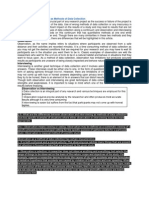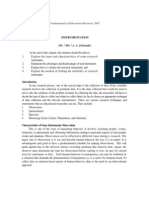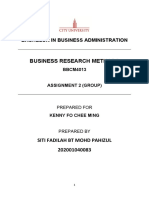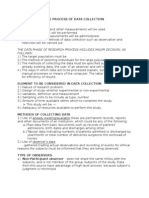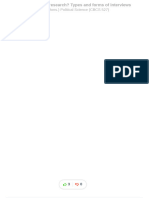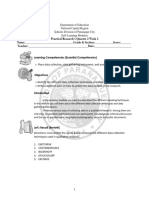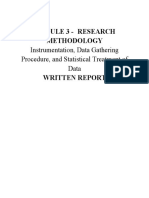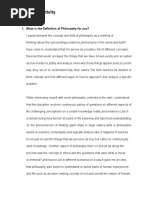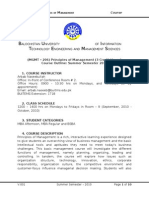0 ratings0% found this document useful (0 votes)
78 viewsModule 3 Strategies Data Collection Pr1
Uploaded by
KainkiankianCopyright
© © All Rights Reserved
Available Formats
Download as PPTX, PDF, TXT or read online on Scribd
0 ratings0% found this document useful (0 votes)
78 viewsModule 3 Strategies Data Collection Pr1
Uploaded by
KainkiankianCopyright
© © All Rights Reserved
Available Formats
Download as PPTX, PDF, TXT or read online on Scribd
You are on page 1/ 33
Module 3:
Strategies for Data
Collection
OBJECTIVES
After going through this module, you are expected
to:
1. Collects data through observation and
interviews. CS_RS11IVd-f-1
2. Infers and explain patterns and themes from
data. CS_RS11IVd-f-2
3. Relates the findings with pertinent literature.
CS_RS11IVd-f-3
Lesson 1: Collecting Data Through Observation
and Interviews
OBSERVATION AS A METHOD OF COLLECTING DATA
Observation is one of the means of collecting data in
qualitative research. As a method, data can be obtained by
watching and listening purposively to people’s behavior
(Almeida et al. 2016, 96). According to Kawulich (2012),
observation is a primary tool that helps you document what
is happening in a particular research setting. Further, she
noted that the researcher’s position in the research setting is
taken into consideration as this will affect the quality of data
that will be collected, the researcher’s relationship with the
participants and the validity of the study.
The two major types of observation are:
1) Participant Observation. This type of observation is
characterized by the researcher’s interaction or participation
with participants and become part of their community
(Driscoll 2011, 160). The researcher acts as observer and
participant at the same time (Kawulich 2012).
2) Direct Observation. In this kind of observation, the
researcher does not participate with the activities of the
group under study. S/He acts as a passive observer (Almeida
et al. 2016, 96) and records the participants’ behavior.
Types of Observational Tools
1) Observation Guide It helps to maintain the observer’s focus
while also giving the observer scope to reflect on the context
associated with each site. The purpose of this observation tool is
to:
o reminds the observer of the key points of observation as well as
the topics of interest associated with each; and
o acts as the motivation for a reflexive exercise in which the
observer can reflect on his/her own relationship and contribution
to the observed at any moment in time (e.g., how the observer was
affected by the observations) (Roller and Lavrakas 2015).
2) Observation Grid
The grid is like the guide in that, it helps remind the
observer of the events and issues of most import;
however, unlike the guide, the observation grid is a
spreadsheet or log of sorts that enables the observer
to record (and record his reflections of) observable
events in relationship to the constructs of interest.
The grid might show, for instance, the relevant
constructs or research issues as column headings
and the specific foci of observation as rows.
When conducting observation in the research setting,
a researcher may play the one of the following:
1) Complete Participant. As the term denotes, the
researcher is part of the group under study and
participates in the group members’ activities.
However, the participants are not aware that they are
being observed and studied.
2) Participant as Observer. Here, the researcher is still
part of the group under study and participates in the
group members’ activities. The participants are fully
aware that they are being observed and studied.
3) Observer as Participant. The researcher is not
part of the group under study but still participates
in the group members’ activities. The participants
under study are aware of the research and its
objectives.
4) Complete Observer. Here, the researcher is not
part of the group under study and does not take
part of their activities. The participants are not also
aware that they are being observed and studied.
Advantages of Observation
1) It enables a researcher to access things in the research
setting that may not seen by the general public (Kawulich
2012).
2) It allows the researcher to give rich and detailed
description of the social setting by means of the field notes
(Kawulich 2012).
3) It is one of the simplest ways to collect data and does not
require too much technical knowledge (Bhasin 2020).
4) It can be done with or without the participants’ knowledge.
Disadvantages of Observation
1) There is a chance of higher observer bias (Bhasin 2020).
2) Participants’ behavior may change because of the presence of
the researcher, thus affecting the data to be obtained
(Educational Research Techniques 2015).
3) It requires longer time frame to obtain deeper understanding of
the research participants.
4) There may be an issue of non-conformity to informed consent.
5) Guidelines in Observation
Here are some guidelines that will help you when doing observation:
1) Be ready with your observation guide and research tools such as
audio-video recorder, camera, and notebook.
2) Focus your observation on the research problems that you are
trying to answer.
3) Take notes or pictures so that you can use them in giving detailed
analysis.
4) Allot ample time in your observation to have a deeper
understanding of the subjects you are observing.
5) Observe keenly. What you think about what you observe may be
opposite to what is really happening.
6) Ask informal questions from the participants for further
Becoming a skilled observer includes…
• Learning to pay attention, see what there is to see, and hear
what there is to hear.
• Practice in writing descriptively.
• Acquiring discipline in recording notes.
• Knowing how to separate detail from trivia.
• Using rigorous methods to validate and triangulate
observations.
• Reporting the strengths and limitations of one’s own
perspective.
Interview
The research interview has been defined as ‘a two-person
conversation initiated by the interviewer for the specific purpose
of obtaining research-relevant information and content specified
by research objectives of systematic description, prediction, or
explanation. It involves the gathering of data through direct verbal
interaction between individuals. It is questioning in the verbal
form. As a research tool, interview is different from general
interviewing in regard to preparation, construction and execution.
It is controlled by the researcher to avoid any biasness and
distortion. In the research interview, the interviewer asks specific
questions pertaining to research objectives and the respondent
answers appropriately.
There are three main kinds of interview that may be used
specifically as research tools:
1) Structured Interview. The structured interview is one in which
the content and procedures are organized in advance. This means
that the sequence and wording of the questions are determined by
means of a schedule and the interviewer is left little freedom to
make modifications. The interviewer asks a predetermined set of
questions which are arranged in chronological order. The
interviewee answers each question from a list of options.
2) Semi-structured Interview. Here, the interviewer asks a predetermined set
of questions. There is no list of options. The interviewee can answer the
questions in his/her own words. Follow-up questions can be asked by the
interviewer for clarifications.
3) Unstructured Interview. The unstructured interview is an open situation,
having greater flexibility and freedom. The research purposes govern the
questions asked, their content, sequence and wording are entirely in the
hands of the interviewer. There is no predetermined set of questions, no list
of options, no specific procedures. The interviewer asks questions on the
context of the study. The interviewee can answer freely and spontaneously.
The interviewer can ask follow-up questions for clarification and for more
in-depth information.
Purposes of the interview
As a distinctive research technique, the interview may serve three purposes.
1) First, it may be used as the principal means of gathering information having
direct bearing on the research objectives.
2) Second, it may be used to test hypotheses or to suggest new ones; or as an
explanatory device to help identify variables and relationships.
3) Third, the interview may be used in conjunction with other methods in a
research undertaking. In this connection, Kerlinger (1970) suggests that it might
be used to follow up unexpected results, for example, or to validate other
methods, or to go deeper into the motivations of respondents and their reasons
for responding as they do.
Advantages of Interview
1) The researcher has the opportunity to ask questions directly to the
participants of the study.
2) It can provide more in-depth information as the researcher is able to raise
follow-up questions to clarify or explore a point.
3) It can supplement information gained from observation, especially those
that are non-verbal in nature.
4) The researcher can explain the questions to the participants.
5) It has a wider application since in can be done with younger to older type
of population.
Disadvantages of Interview
1) It can be time consuming for the researcher and the
interviewee.
2) It requires the researcher to arrange the time and
place of interview.
3) A limited number of people can be interviewed due to
time restrictions.
4) The data obtained from limited number of participants
may not reflect the views of a wider population.
Interview Protocol
An interview protocol is more than a list of interview questions; it
also extends to the procedural level of interviewing and includes a
script of what you will say before the interview, script for what you
will say at the conclusion of the interview, prompts for the
interviewer to collect informed consent, and prompts to remind the
interviewer the information that she or he is interested in
collecting. Interview protocols become not only a set of questions,
but also a procedural guide for directing a new qualitative
researcher through the interview process.
Writing Successful Interview Protocols
1) Pick a topic that is interesting to you.
2) Research should guide your questions.
3) Use a script for the beginning and end of your
interview.
4) Questions should be open ended.
5) Start with the basics.
6) Begin with easy to answer questions and move
towards ones that are more difficult or controversial.
Writing Successful Interview Protocols
7) The phrase “tell me about…”is great way to start a question.
8) Write big, expansive questions.
9) Use prompts.
10) Be willing to make “on the spot” revisions to your interview protocol.
11) Do not make the interview too long.
12) Practice with a friend.
13) Make sure that you have set up a second shorter interview to help you clarify
14) If needed, clear your project with your school’s Institutional Research Board
(IRB).
Tips for the Interview
1) Start with your script. You developed the script so that you do not
inadvertently neglect sharing important information with your
interviewee. While you do not need to read the script word for word, it
is important that you have it in front of you and you follow it carefully.
2) Collect consent. Collecting consent should be a part of your
beginning script. Do not proceed with your interview without collecting
it. Give your participant plenty of time to read through the form and
ask as many questions about consent as she or he needs to ask.
3) Use some type of recording device and only take brief notes so you
can maintain eye contact with your interviewee.
4) Arrange to interview your respondent in a quiet, semi-private place.
5) Be sure that both you and the interviewee block off
plenty of uninterrupted time for the interview.
6) Have genuine care, concern, and interest for the
person you are interviewing.
7) Use basic counseling skills to help your interviewees
feel heard.
8) Keep it focused.
9) LISTEN! LISTEN! LISTEN! Seriously, close your
mouth and listen!
10) End with your script.
Inferring Patterns and Themes from
Data in Research
What is Coding?
Coding is the process of analyzing the data and searching
for essential information that answers the research
questions. Another definition of coding says that it is a
process of filtering the data. These essential words are
marked or labeled or coded. They are considered essential
if they occur or have been mentioned several times by the
informants.
Two types of codes in qualitative research:
1) PRESET are codes that have been identified prior to
analysis. It is also called the deductive approach
wherein the codes/themes were determined
beforehand, either from related theories or existing
knowledge
2) EMERGENT CODES are those that show up during
analysis. It is also referred to as inductive approach
where the data is the one that determine the
codes/themes.
What is collating?
Collating on the other hand is, your way of
bringing together the coded data. Giving
the data an orderly appearance is putting
them in a graph, specifically a table of
responses.
PATTERNS AND THEMES
Patterns and themes are words or phrases that
collectively describe the experience or thoughts of
every participant. These words and phrases
become themes because they appear on several
occasions and are mentioned by many
participants. They represent broad categories of
information.
In order to identify themes, qualitative researchers use
codes. Just like what is written above, these codes are
simply “labels” that help qualitative researchers identify
similar experiences or thoughts.
Codes that are grouped together are themes. These are
the words or phrases that will manifest in the interview
transcript and researchers during analysis. Qualitative
researchers should be able to identify and locate them.
Hence, these words or phrases that describe participants’
experiences and thoughts should be coded accordingly for
easy reference and classification when interpreting the
results.
Below are the 5-step process to analyze your data:
1) Prepare and organize your data. Make sure
that you have the transcript with you, collect
all the notes you have taken, documents and
other materials needed. Do not forget the
sources.
2) Review and explore the data. Read and
understand each of those documents and
notes.
Below are the 5-step process to analyze your data:
3) Create initial codes. While you are at the reading
mode, this would also be the time to generate codes.
4) Review those codes and revise or combine into themes.
After reading and coding all the materials, identify
recurring themes, language, opinions, and beliefs.
5) Present themes in a cohesive manner. Lay these
themes consistently and taking into consideration the
audience, and the goals of your research. The findings
should address each theme in turn and refer to your
statement of the problem.
You might also like
- Hourglass Workout Program by Luisagiuliet 276% (21)Hourglass Workout Program by Luisagiuliet 251 pages
- The Hold Me Tight Workbook - Dr. Sue Johnson100% (16)The Hold Me Tight Workbook - Dr. Sue Johnson187 pages
- Read People Like A Book by Patrick King-Edited62% (66)Read People Like A Book by Patrick King-Edited12 pages
- Livingood, Blake - Livingood Daily Your 21-Day Guide To Experience Real Health77% (13)Livingood, Blake - Livingood Daily Your 21-Day Guide To Experience Real Health260 pages
- COSMIC CONSCIOUSNESS OF HUMANITY - PROBLEMS OF NEW COSMOGONY (V.P.Kaznacheev,. Л. V. Trofimov.)94% (212)COSMIC CONSCIOUSNESS OF HUMANITY - PROBLEMS OF NEW COSMOGONY (V.P.Kaznacheev,. Л. V. Trofimov.)212 pages
- Donald Trump & Jeffrey Epstein Rape Lawsuit and Affidavits83% (1016)Donald Trump & Jeffrey Epstein Rape Lawsuit and Affidavits13 pages
- The 36 Questions That Lead To Love - The New York Times94% (34)The 36 Questions That Lead To Love - The New York Times3 pages
- The 36 Questions That Lead To Love - The New York Times95% (21)The 36 Questions That Lead To Love - The New York Times3 pages
- Jeffrey Epstein39s Little Black Book Unredacted PDF75% (12)Jeffrey Epstein39s Little Black Book Unredacted PDF95 pages
- The 4 Hour Workweek, Expanded and Updated by Timothy Ferriss - Excerpt23% (954)The 4 Hour Workweek, Expanded and Updated by Timothy Ferriss - Excerpt38 pages
- Methods of Research: Simple, Short, And Straightforward Way Of Learning Methods Of ResearchFrom EverandMethods of Research: Simple, Short, And Straightforward Way Of Learning Methods Of Research4.5/5 (6)
- Observation Vs Interviewing As Methods of Data Collection56% (9)Observation Vs Interviewing As Methods of Data Collection2 pages
- WEEK 9 Collecting Data Through Observation and InterviewsNo ratings yetWEEK 9 Collecting Data Through Observation and Interviews16 pages
- Practical Research Ii: Happylearni NG With Teacher CamilleNo ratings yetPractical Research Ii: Happylearni NG With Teacher Camille39 pages
- Quantitative & Qualitative InstrumentationNo ratings yetQuantitative & Qualitative Instrumentation10 pages
- Chapter Four The Sources and Collection of Data100% (1)Chapter Four The Sources and Collection of Data6 pages
- Practical Research 1: Data Collection, Data Gathering Instrument, and Analysis ProceduresNo ratings yetPractical Research 1: Data Collection, Data Gathering Instrument, and Analysis Procedures7 pages
- Lesson 1: PRACTICAL RESEARCH 2 Quarter 2 - Module 2 Data Collection, Presentation, and AnalysisNo ratings yetLesson 1: PRACTICAL RESEARCH 2 Quarter 2 - Module 2 Data Collection, Presentation, and Analysis5 pages
- Good Day Marians!: Practical Research 1No ratings yetGood Day Marians!: Practical Research 151 pages
- t7 Action Research Data Collection MethodsNo ratings yett7 Action Research Data Collection Methods10 pages
- Grade: Self-Learning Module in PRACTICAL RESEARCH I Lesson100% (1)Grade: Self-Learning Module in PRACTICAL RESEARCH I Lesson8 pages
- what-is-survey-research-types-and-forms-of-interviews_compressNo ratings yetwhat-is-survey-research-types-and-forms-of-interviews_compress7 pages
- Case Study in Sofware Engineering: Danilo Martínez EspinozaNo ratings yetCase Study in Sofware Engineering: Danilo Martínez Espinoza27 pages
- ANSWERS 1 Research Methodology Year III Semester II SepNo ratings yetANSWERS 1 Research Methodology Year III Semester II Sep13 pages
- Instrumentation/Data Gathering Tools and Techniques in Quantitative and Qualitative Methods100% (2)Instrumentation/Data Gathering Tools and Techniques in Quantitative and Qualitative Methods8 pages
- Name: Lydia Aviodita Class: VI.A NPM: 1421110074 Chapter Report Survey ResearchNo ratings yetName: Lydia Aviodita Class: VI.A NPM: 1421110074 Chapter Report Survey Research3 pages
- Finding Answers Through Data Collection and Analyzing The Meaning of Qualitative DataNo ratings yetFinding Answers Through Data Collection and Analyzing The Meaning of Qualitative Data22 pages
- R201238H Kumbirai Cassinos Tasaranarwo Chapter 3No ratings yetR201238H Kumbirai Cassinos Tasaranarwo Chapter 39 pages
- Methods of Research: By: Mary Anna Rosario C. Agatep-Directo, M.A.Ed., M.I.T. Instructor INo ratings yetMethods of Research: By: Mary Anna Rosario C. Agatep-Directo, M.A.Ed., M.I.T. Instructor I41 pages
- Lesson 5 - Research Design and Methodology (Rev)No ratings yetLesson 5 - Research Design and Methodology (Rev)17 pages
- Research Methods and Methods in Context Revision Notes for AS Level and A Level Sociology, AQA FocusFrom EverandResearch Methods and Methods in Context Revision Notes for AS Level and A Level Sociology, AQA FocusNo ratings yet
- Participatory Action Research for Evidence-driven Community DevelopmentFrom EverandParticipatory Action Research for Evidence-driven Community DevelopmentNo ratings yet
- 50 POSITIVE HABITS TO TRANSFORM YOUR LIFE BY MICHAEL CHAPMAN Book Summary and PDF100% (1)50 POSITIVE HABITS TO TRANSFORM YOUR LIFE BY MICHAEL CHAPMAN Book Summary and PDF6 pages
- Use Quotation Marks in Direct Speech. Someone Said But Not The Exact Words. We Do Not Use Quotation Marks in Reported SpeechNo ratings yetUse Quotation Marks in Direct Speech. Someone Said But Not The Exact Words. We Do Not Use Quotation Marks in Reported Speech4 pages
- Engl2550 Assignment1 Observe Report InspectNo ratings yetEngl2550 Assignment1 Observe Report Inspect8 pages
- Eigenfaces Vs Fisher Faces PresentationNo ratings yetEigenfaces Vs Fisher Faces Presentation28 pages
- CELPIP General Overview Participant PackageNo ratings yetCELPIP General Overview Participant Package22 pages
- E Book 2 Design Am I in The Wrong ProfessionNo ratings yetE Book 2 Design Am I in The Wrong Profession23 pages
- Teacher Humor Style and Attention Span of Grade 7 StudentsNo ratings yetTeacher Humor Style and Attention Span of Grade 7 Students5 pages
- (Luận văn) a translation quality assessment of the first three chapters of the novel the da vinci code by do thu ha (2005) based on j houses modelNo ratings yet(Luận văn) a translation quality assessment of the first three chapters of the novel the da vinci code by do thu ha (2005) based on j houses model83 pages
- Conceptualization: On Theory and Theorizing Using Grounded Theory100% (1)Conceptualization: On Theory and Theorizing Using Grounded Theory31 pages
- Livingood, Blake - Livingood Daily Your 21-Day Guide To Experience Real HealthLivingood, Blake - Livingood Daily Your 21-Day Guide To Experience Real Health
- COSMIC CONSCIOUSNESS OF HUMANITY - PROBLEMS OF NEW COSMOGONY (V.P.Kaznacheev,. Л. V. Trofimov.)COSMIC CONSCIOUSNESS OF HUMANITY - PROBLEMS OF NEW COSMOGONY (V.P.Kaznacheev,. Л. V. Trofimov.)
- Donald Trump & Jeffrey Epstein Rape Lawsuit and AffidavitsDonald Trump & Jeffrey Epstein Rape Lawsuit and Affidavits
- The 36 Questions That Lead To Love - The New York TimesThe 36 Questions That Lead To Love - The New York Times
- The 36 Questions That Lead To Love - The New York TimesThe 36 Questions That Lead To Love - The New York Times
- Jeffrey Epstein39s Little Black Book Unredacted PDFJeffrey Epstein39s Little Black Book Unredacted PDF
- The 4 Hour Workweek, Expanded and Updated by Timothy Ferriss - ExcerptThe 4 Hour Workweek, Expanded and Updated by Timothy Ferriss - Excerpt
- Methods of Research: Simple, Short, And Straightforward Way Of Learning Methods Of ResearchFrom EverandMethods of Research: Simple, Short, And Straightforward Way Of Learning Methods Of Research
- Observation Vs Interviewing As Methods of Data CollectionObservation Vs Interviewing As Methods of Data Collection
- WEEK 9 Collecting Data Through Observation and InterviewsWEEK 9 Collecting Data Through Observation and Interviews
- Practical Research Ii: Happylearni NG With Teacher CamillePractical Research Ii: Happylearni NG With Teacher Camille
- Practical Research 1: Data Collection, Data Gathering Instrument, and Analysis ProceduresPractical Research 1: Data Collection, Data Gathering Instrument, and Analysis Procedures
- Lesson 1: PRACTICAL RESEARCH 2 Quarter 2 - Module 2 Data Collection, Presentation, and AnalysisLesson 1: PRACTICAL RESEARCH 2 Quarter 2 - Module 2 Data Collection, Presentation, and Analysis
- Grade: Self-Learning Module in PRACTICAL RESEARCH I LessonGrade: Self-Learning Module in PRACTICAL RESEARCH I Lesson
- what-is-survey-research-types-and-forms-of-interviews_compresswhat-is-survey-research-types-and-forms-of-interviews_compress
- Case Study in Sofware Engineering: Danilo Martínez EspinozaCase Study in Sofware Engineering: Danilo Martínez Espinoza
- ANSWERS 1 Research Methodology Year III Semester II SepANSWERS 1 Research Methodology Year III Semester II Sep
- Instrumentation/Data Gathering Tools and Techniques in Quantitative and Qualitative MethodsInstrumentation/Data Gathering Tools and Techniques in Quantitative and Qualitative Methods
- Name: Lydia Aviodita Class: VI.A NPM: 1421110074 Chapter Report Survey ResearchName: Lydia Aviodita Class: VI.A NPM: 1421110074 Chapter Report Survey Research
- Finding Answers Through Data Collection and Analyzing The Meaning of Qualitative DataFinding Answers Through Data Collection and Analyzing The Meaning of Qualitative Data
- Methods of Research: By: Mary Anna Rosario C. Agatep-Directo, M.A.Ed., M.I.T. Instructor IMethods of Research: By: Mary Anna Rosario C. Agatep-Directo, M.A.Ed., M.I.T. Instructor I
- Research Methods and Methods in Context Revision Notes for AS Level and A Level Sociology, AQA FocusFrom EverandResearch Methods and Methods in Context Revision Notes for AS Level and A Level Sociology, AQA Focus
- Participatory Action Research for Evidence-driven Community DevelopmentFrom EverandParticipatory Action Research for Evidence-driven Community Development
- 50 POSITIVE HABITS TO TRANSFORM YOUR LIFE BY MICHAEL CHAPMAN Book Summary and PDF50 POSITIVE HABITS TO TRANSFORM YOUR LIFE BY MICHAEL CHAPMAN Book Summary and PDF
- Use Quotation Marks in Direct Speech. Someone Said But Not The Exact Words. We Do Not Use Quotation Marks in Reported SpeechUse Quotation Marks in Direct Speech. Someone Said But Not The Exact Words. We Do Not Use Quotation Marks in Reported Speech
- Teacher Humor Style and Attention Span of Grade 7 StudentsTeacher Humor Style and Attention Span of Grade 7 Students
- (Luận văn) a translation quality assessment of the first three chapters of the novel the da vinci code by do thu ha (2005) based on j houses model(Luận văn) a translation quality assessment of the first three chapters of the novel the da vinci code by do thu ha (2005) based on j houses model
- Conceptualization: On Theory and Theorizing Using Grounded TheoryConceptualization: On Theory and Theorizing Using Grounded Theory
































